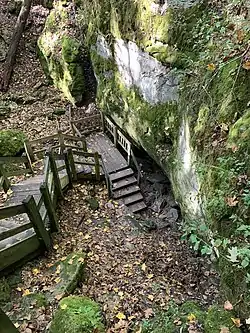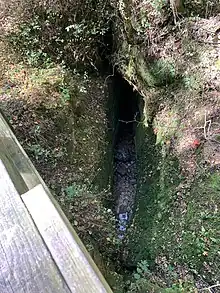Devil's Icebox (cave)
Devil's Icebox is a cave located in Rock Bridge Memorial State Park in Columbia, Missouri.[1] It is said to be one of the longest caves in the state of Missouri and is one of the caves with the highest number of species in the state.[2] It is currently closed to protect the endangered Indiana bat,[3] and is the only known natural home of the species Kenkia glandulosa or pink planarian.
| Devil’s Icebox | |
|---|---|
 | |
| Geology | Limestone |
| Entrances | 1 |
| Show cave length | 7 miles (11 km) |
Name

The cave was probably given the name Devil's Icebox by people living in area during the early 1800s. The word icebox in the name probably came from the very cold air that leaks from the cave all year. In 1926, the name of the cave was printed in an article about the earliest exploration of the cave in 1924.[4]
History
The stream that flows through Devil's Icebox Cave was a source of power for settlers in the 19th century.[5]
The earliest exploration of the cave took place in 1924.[4] A man named Ben M Yates claimed he was the first one to explore that cave, he along with his sons went into the cave with a john-long boat and other items. They were said to have explored the cave for 24 hours and traveled 5 miles.[6]
Access to the cave was restricted in 2006.[7] Then in 2010, tours to the general public stopped[8] to protect the bats from white-nose syndrome.[9] Despite this, the disease affected the caves in Rock Bridge during 2013.[8]
Characteristics
Temperature
The cave is said to be as cold as 56 degrees all year round.[9] It is also said to have a temperature of 13 degrees.[10]
Species
According to the U.S. Government Printing Office, Devil's Icebox has the second highest number of species out of the over 6000 caves in Missouri. In 2007, 80 species have been identified in the cave.[2]
It is the only place where the species Macrocotyla glandulosa has been found;[11] the rarity of this species was once used as an argument to prevent the construction of a shopping mall in the area.[12]: 83 The cave is also home to species of salamanders, frogs, troglobites, millipede, spiders, and springtail.[3] There are even endangered bat species like Myotis sodalis, Myotis septentrionalis, and Myotis grisescens in the cave.[3][13]
Length
It is said to be the seventh[1] or sixth longest cave in Missouri,[14] with it spanning 7 miles.[9] In the year 1986 its length was measured to be over 30 thousand in feet, 5.76 miles, and 9.27 kilometers.[15]
Geology
The cave is a double sink hole.[5] It was formed in Burlington Limestone[16] which had formed 300 million years ago.[3] The cave is an example of karst topography.[9] According to J Harlen Bretz, Devil's Icebox is a phreatic cave system.[17]: 286
In January 1994, a stream in the cave was oversaturated with calcite and dolomite.[18] In 2017 stalagmites in the cave were studied.[10] All the water flowing in the cave is from the surface.[19]
References
- Strait, James (2008). Weird Missouri: Your Travel Guide to Missouri's Local Legends and Best Kept Secrets. Sterling Publishing Company, Inc. p. 16. ISBN 978-1-4027-4555-3.
- S ), Nuclear Regulatory Commission (U (May 16, 2017). Environmental Impact Statement for Construction Permit for the Northwest Medical Isotopes Radioisotope Production Facility Final Report. Government Printing Office. pp. 3–47. ISBN 978-0-16-093916-7.
- Pycior, Danielle. "Explore the science behind local landmarks from Devil's Icebox to the Pinnacles". Vox Magazine. Retrieved October 17, 2021.
- "Devil's Icebox Cave". Columbia Missourian. Retrieved October 17, 2021.
- jennifer.sieg (February 6, 2011). "General Information". mostateparks.com. Retrieved October 17, 2021.
- "[PDF] 028 (Oct-Dec 1974) - National Speleological Society - Free Download PDF".
- Thornton, Michaella A. (February 20, 2019). "Devil's Icebox". Common Reader. Retrieved October 17, 2021.
- Heimsoth, Josie. "Cave explorers discover the secrets of Devil's Icebox". Columbia Missourian. Retrieved October 17, 2021.
- "Devil's Icebox". Atlas Obscura. Retrieved October 17, 2021.
- Denniston, Rhawn F.; DuPree, Michelle; Dorale, Jeffrey A.; Asmerom, Yemane; Polyak, Victor J.; Carpenter, Scott J. (July 2007). "Episodes of late Holocene aridity recorded by stalagmites from Devil's icebox Cave, Central Missouri, USA". Quaternary Research. 68 (1): 45–52. Bibcode:2007QuRes..68...45D. doi:10.1016/j.yqres.2007.04.001. ISSN 0033-5894. S2CID 55987488.
- "Turbellarians (Planarians; Free-Living Flatworms)". Missouri Department of Conservation. Retrieved October 17, 2021.
- Díaz, Aldemaro Romero; Romero, Aldemaro (July 23, 2009). Cave Biology: Life in Darkness. Cambridge University Press. ISBN 978-0-521-82846-8.
- S ), Nuclear Regulatory Commission (U (May 16, 2017). Environmental Impact Statement for Construction Permit for the Northwest Medical Isotopes Radioisotope Production Facility Final Report. Government Printing Office. pp. 3–46. ISBN 978-0-16-093916-7.
- Kansas City: Getaway Ideas for the Local Traveler. Rowman & Littlefield. pp. 46–47. ISBN 978-0-7627-5214-0.
- Unklesbay, Athel Glyde; Vineyard, Jerry D. (1992). Missouri Geology: Three Billion Years of Volcanoes, Seas, Sediments, and Erosion. University of Missouri Press. p. 55. ISBN 978-0-8262-0836-1.
- https://www.ars.usda.gov/ARSUserFiles/50701000/cswq-0489-lerch.pdf
- Bretz, J. Harlen (1956). Caves of Missouri. State of Missouri, Department of Business & Administration.
- Wicks, Carol M; Engeln, Joseph F (November 1, 1997). "Geochemical evolution of a karst stream in Devils Icebox Cave, Missouri, USA". Journal of Hydrology. 198 (1): 30–41. Bibcode:1997JHyd..198...30W. doi:10.1016/S0022-1694(96)03328-8. ISSN 0022-1694.
- https://digital.lib.usf.edu//content/SF/S0/05/06/48/00001/K26-00199-671-1401-1-SM.pdf